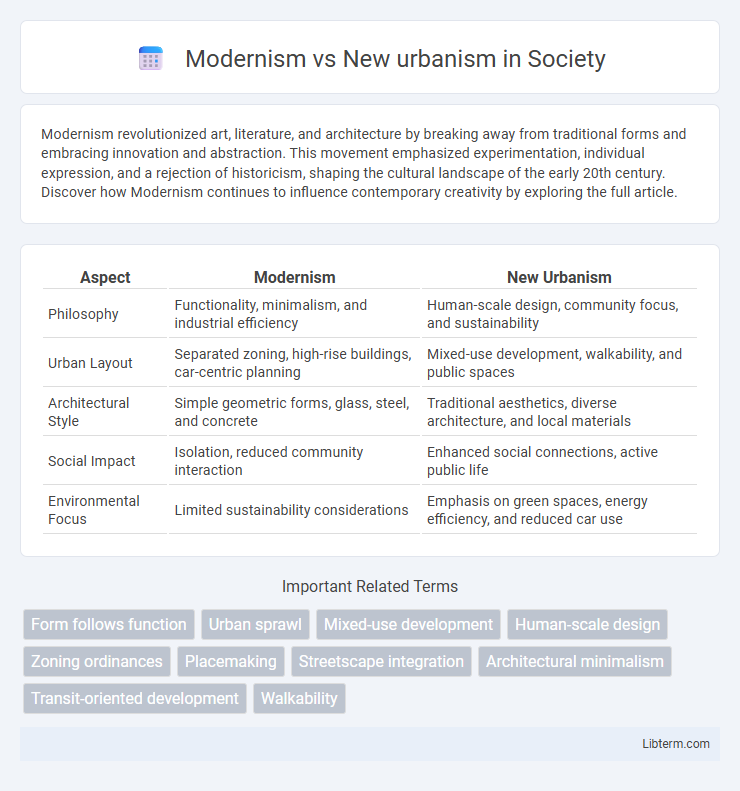Modernism revolutionized art, literature, and architecture by breaking away from traditional forms and embracing innovation and abstraction. This movement emphasized experimentation, individual expression, and a rejection of historicism, shaping the cultural landscape of the early 20th century. Discover how Modernism continues to influence contemporary creativity by exploring the full article.
Table of Comparison
| Aspect | Modernism | New Urbanism |
|---|---|---|
| Philosophy | Functionality, minimalism, and industrial efficiency | Human-scale design, community focus, and sustainability |
| Urban Layout | Separated zoning, high-rise buildings, car-centric planning | Mixed-use development, walkability, and public spaces |
| Architectural Style | Simple geometric forms, glass, steel, and concrete | Traditional aesthetics, diverse architecture, and local materials |
| Social Impact | Isolation, reduced community interaction | Enhanced social connections, active public life |
| Environmental Focus | Limited sustainability considerations | Emphasis on green spaces, energy efficiency, and reduced car use |
Introduction to Modernism and New Urbanism
Modernism in architecture and urban planning emerged in the early 20th century, emphasizing functional design, minimalism, and the use of new materials like steel and concrete to create efficient, machine-like structures. New Urbanism, developing in the late 20th century, advocates for walkable, mixed-use communities that prioritize human scale, sustainability, and traditional neighborhood patterns to counteract urban sprawl. The fundamental contrast lies in Modernism's focus on innovation and abstraction versus New Urbanism's emphasis on community, connectivity, and environmental integration.
Historical Context: Origins of Both Movements
Modernism, emerging in the early 20th century, was rooted in the aftermath of World War I, emphasizing functionalism, minimalism, and the rejection of historical architectural styles, reflecting industrialization and technological progress. New Urbanism arose in the late 20th century as a reaction to suburban sprawl and automobile dependence, promoting walkable neighborhoods, mixed-use development, and traditional town planning principles inspired by pre-industrial urban structures. Both movements respond to social and environmental challenges of their times, with Modernism focused on innovation and efficiency, while New Urbanism centers on community and sustainability.
Core Philosophies: Modernism vs New Urbanism
Modernism in urban design emphasizes functional zoning, large-scale urban renewal, and separation of uses to create efficient, machine-like cities. New Urbanism advocates for walkable, mixed-use neighborhoods that promote community interaction, sustainability, and human-scale development. The core philosophical divide lies in Modernism's focus on form and function through separation, contrasted with New Urbanism's integration of social, environmental, and spatial elements to foster vibrant, livable communities.
Urban Design Principles Compared
Modernism in urban design emphasizes functional zoning, large-scale separation of uses, and the prioritization of vehicular traffic with wide roads and isolated buildings, often resulting in less pedestrian-friendly environments. New Urbanism advocates for mixed-use development, walkability, human-scaled architecture, and interconnected street networks designed to foster community interaction and reduce dependence on cars. Key principles of New Urbanism include compact neighborhoods, diverse housing options, and public spaces that encourage social engagement, contrasting with Modernism's focus on efficiency and separation.
Architectural Styles and Aesthetic Values
Modernism in architecture emphasizes functional forms, minimal ornamentation, and the use of industrial materials such as steel, glass, and concrete, promoting a sleek, geometric aesthetic that prioritizes simplicity and efficiency. New Urbanism, by contrast, advocates for traditional architectural styles that foster community interaction, integrating elements like pitched roofs, detailed facades, and human-scale proportions to create walkable, pedestrian-friendly neighborhoods. The aesthetic values of Modernism center on abstraction and innovation, whereas New Urbanism values historical continuity, vernacular designs, and visually cohesive streetscapes.
Land Use and Community Planning Approaches
Modernism in urban planning emphasizes zoning separation and large-scale infrastructure, promoting functional specialization in land use with distinct residential, commercial, and industrial areas. New Urbanism advocates for mixed-use developments that integrate residential, commercial, and recreational spaces, fostering walkability and community interaction. This approach prioritizes human-scale design, connectivity, and sustainability to counteract the sprawl and isolation typical of Modernist planning.
Transportation and Mobility Solutions
Modernism in urban planning emphasized car-centric designs with wide roads and segregated land uses, resulting in limited pedestrian accessibility and dependence on automobiles. New Urbanism promotes walkable neighborhoods, mixed-use developments, and integrated public transit systems to reduce car dependency and enhance mobility options. By prioritizing multi-modal transportation solutions, New Urbanism supports sustainable transit modes such as biking, walking, and public transportation, contributing to reduced traffic congestion and lower environmental impact.
Environmental Sustainability Perspectives
Modernism in urban planning often prioritizes functional zoning and automobile dependency, which can lead to increased energy consumption and environmental degradation. New Urbanism emphasizes walkable neighborhoods, mixed-use development, and green infrastructure, promoting lower carbon footprints and enhanced ecological resilience. This approach supports sustainable living by integrating natural systems and reducing reliance on fossil fuels through compact, transit-oriented design.
Social Impact and Community Engagement
Modernism in urban planning often emphasizes functional zoning and large-scale infrastructure, which can lead to social segregation and reduced community interaction. New Urbanism prioritizes walkable neighborhoods, mixed-use development, and public spaces, fostering stronger social ties and active community engagement. Its design principles aim to enhance inclusivity, promote local economies, and encourage participatory planning processes that empower residents.
Future Trends: The Evolving Urban Landscape
Modernism in urban design, characterized by functional zoning and high-rise buildings, faces challenges as sustainability and community-centric planning grow in importance. New Urbanism emphasizes walkability, mixed-use developments, and green spaces, aligning with future trends toward reducing carbon footprints and enhancing social cohesion. The evolving urban landscape increasingly integrates smart technologies and resilient infrastructure, reflecting a blend of modernist efficiency and New Urbanist human-scale principles.
Modernism Infographic

 libterm.com
libterm.com